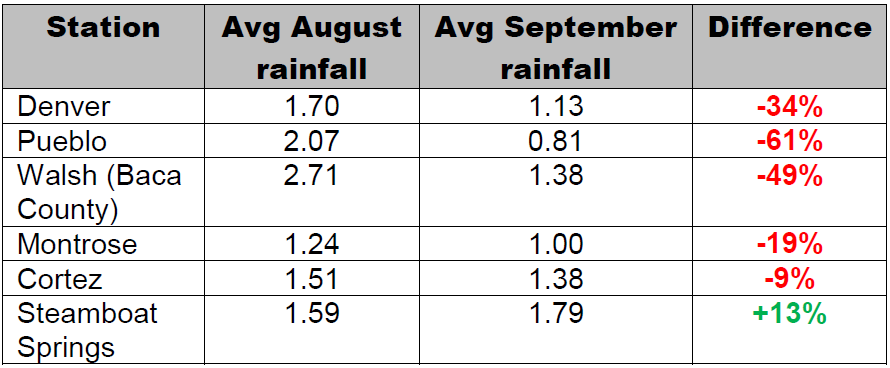Issue Date: 8/13/2015
Issue Time: 11:20AM
Valid Dates: 8/14 – 8/28
 A BRIEF BLURB ON CLIMATOLOGY
A BRIEF BLURB ON CLIMATOLOGY
Climatologically speaking, August is a transition month for most of Colorado. Over the course of the month, our state goes from seeing almost daily thunderstorm activity (especially over the higher terrain) to the slightly cooler and much drier weather that signals the start of fall. Comparing historical average August and September rainfall at a few locations generally emphasizes the point above:
 Almost all lower-elevation locations experience steep drops in precipitation from August to September. However, this is not necessarily the case for higher elevation locations (example: Steamboat Springs) where fall cold fronts can cause ample precipitation due to persistent upslope flow.
Almost all lower-elevation locations experience steep drops in precipitation from August to September. However, this is not necessarily the case for higher elevation locations (example: Steamboat Springs) where fall cold fronts can cause ample precipitation due to persistent upslope flow.
OVERVIEW
For this Flood Threat Outlook, we see a transition in store for our weather. Let us first investigate what today’s weather map shows. As seen in the water vapor image, below, there are some features that we have seen in the last few weeks. Colorado is sitting under a stout upper-level ridge. However, very high residual moisture implies that rainfall chances will not be completely suppressed. A moderately moist monsoonal feed continues to the west of Colorado. However, we do not expect to see significant moisture transport into our state over the next week. This implies that rainfall chances will hinge strongly on the availability of residual moisture. Over the next five to seven days, this will not be a problem (precipitable water values are expected to stay well above climatology through next week).
 Next, we see two low-pressure disturbances located over the Central and Eastern Pacific. Each of these will, at varying speeds, move eastward towards Colorado over the next week or so. Each disturbance is expected to bring with it a Pacific-origin cool front that will elevate rainfall chances. However, with little to no monsoonal support, the majority of the rainfall is expected to stay east of the Divide. After the passage of the second system (mid next week), there are indications of much cooler weather for the Northern Plains and Rockies. It is not clear how far south this cool weather will penetrate, but at the very least, it should result in substantial drying of the atmosphere and thus, heavy rainfall chances.
Next, we see two low-pressure disturbances located over the Central and Eastern Pacific. Each of these will, at varying speeds, move eastward towards Colorado over the next week or so. Each disturbance is expected to bring with it a Pacific-origin cool front that will elevate rainfall chances. However, with little to no monsoonal support, the majority of the rainfall is expected to stay east of the Divide. After the passage of the second system (mid next week), there are indications of much cooler weather for the Northern Plains and Rockies. It is not clear how far south this cool weather will penetrate, but at the very least, it should result in substantial drying of the atmosphere and thus, heavy rainfall chances.
Now getting to the specifics, we anticipate two precipitation Events over the period covered by this Flood Threat Outlook. Each of these will bring with it an Elevated flood threat. Let’s look at the details of each Event:
Event #1: Friday (8/14) through Sunday (8/16)
An Elevated flood threat for the Front Range and eastern Plains
Upslope flow will develop on Friday and persist through Sunday as a low pressure brings a cool front southward across the eastern Plains of Colorado. On Friday, most activity will be limited to the higher terrain with rainfall amounts up to 1 inch possible. On Saturday, activity will spread into the Northeast Plains, while Sunday activity will focus on the Palmer Ridge and Southeast Plains. In total rainfall totals up to 2.5 inches will be possible, especially over the Palmer Ridge where areas will likely receive a heavy rainfall threat on multiple days. Due to the atmospheric dynamics, we expect one round of storms each day, which will limit the overall flood threat.
Event #2: Tuesday (8/18) through Thursday (8/20)
An Elevated flood threat for the eastern Plains
Another low pressure system will dive southeastward and enter the North American coast somewhere between California and Washington. The farther southward positioning of this system is more conducive to a heavy rainfall threat, compared to Event #1. However, the system is expected to move very rapidly, which will put a cap on the overall flood threat. Nonetheless, we expect two to possibly three days of Elevated flood threats as the system crosses over Colorado. Daily storm activity will yield up to 1.5 inches of rainfall on any given day. The Northeast Plains will likely have highest overall rain totals due to access to higher moisture content. There is some uncertainty as to the system’s speed so it is possible that Thursday will be completely dry. There is also some indication that this system will some substantially drier air, which could limit the heavy rainfall chances, especially over and west of the Continental Divide.
